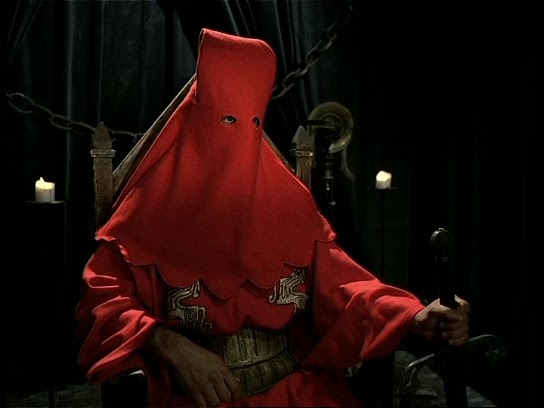Cut to fifty years previous. The Red Monks introduces Robert Garlini (Gerardo Amato), the current owner of the villa. He hears upon his balcony the barking of his dog and heads out upon the grounds to see what has stirred the animal. The dog has chased pretty young Ramona (Lara Wendel) up a tree, and she only wandered onto the grounds to paint a landscape portrait. Robert invites Ramona into his home and asks Pricilla (Malisa Longo), the housekeeper, to hem Ramona’s dress. Robert sees his meeting with Ramona as Providence, and soon after, the two are married. On their wedding night, Pricilla tells Robert that he has an urgent meeting. Robert descends into the villa’s catacombs and dungeon and encounters a group of golden-sword wielding, red-robed monks. They tell Robert that in exchange for his wealth and fortune, he must sacrifice the blood of a virgin and offer her blood as a tribute. The monks select his newlywed bride. Robert bitches and moans a little bit but concedes. In their bedroom, Robert is unable to consummate their marriage, and Ramona becomes despondent in her stay at the villa. She becomes curious and starts to investigate the history of her surroundings.
The Red Monks is never totally engaging, but that is not to say, it does not have its charms. Despite being a horror film, The Red Monks lacks both atmosphere and scares. The dynamics are present to create a psychosexual horror film or a psychosexual drama, a la Joe D’Amato; but it does not dare to go there. The film really only hints at its potential. The two lead actresses, Wendel and Longo, are the main attraction, and their presence elevates this film slightly out of its obscurity. At times, I even forgot The Red Monks was a horror film. In one of the only murder sequences, Lucille (Mary Maxwell), the very stereotypical French maid who has become Ramona’s confidant, spies a figure lurking about the grounds. It is clearly one of the red monks. Lucille wanders around the trees and is decapitated by the monk. After Robert and Romana have a spat, they decide to have a picnic on a sunny day on the grounds. Romana opens the picnic basket and out pours Lucille’s head. This scene is representative of the scare level of The Red Monks. In one of the film’s best sequences, Ramona blows off Robert at bedtime for his lack of understanding and for being so unaffectionate towards her. Robert visits Pricilla in her chambers and demands that she stop being jealous towards Ramona. Pricilla reveals that she was given to Robert and that her affection should be enough for him. Robert starts fucking Pricilla, and Ramona sees them through a crack in the doorway. She grimaces at the sight, and Ramona is obviously hurt; but glances and grimaces are about all these characters give each other. A confrontation is rarely in sight.
The highlights of The Red Monks are the genuine Italian locations, period costumes, and props, all from the 1940s. They are all simply beautiful. The performances by Wendel and Longo are very good, and each is quite sensuous in her role. The script by director Gianni Martucci, Pino Buricchi, and Luciana Anna Spacca is poor: no real tension is created by the story or with the characters. Martucci’s direction is average. I frati rossi is notable for having Lucio Fulci as one of the producers. Fulci has stated that his involvement in the film is as thus: “The producers begged me to help promote the film. I don’t even know the director.” (*) Isn’t that something?
* “The Lucio Fulci Interview.” Conducted by Loris Curci & Antonio
Tentori. European Trash Cinema. Vol.
2. No. 4. Ed. Craig Ledbetter. Kingwood, TX.
1991: p. 7.



2 comments:
I found this one a bit of a grower. First viewing I found it to be a little meh, but with subsequent viewings I appreciated its charm a little more. It's obviously from a period when Italian genre film was in near terminal decline and it does have that late eighties cheapness. But, for that, it is probably more successfully in execution than so many of its contemporaries. Despite the lack of Fulci involvement, beyond being a name on the box, it does feel a like a Lucio film of the period.
when you see Gaetano Russo in the cast, you should know what you're in for
Post a Comment